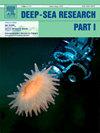利用机会取样的深海生物群落分类:对未来管理的见解
IF 2.1
3区 地球科学
Q2 OCEANOGRAPHY
Deep-Sea Research Part I-Oceanographic Research Papers
Pub Date : 2025-10-08
DOI:10.1016/j.dsr.2025.104604
引用次数: 0
摘要
研究人员在东北大西洋的Tropic Seamount海域开发并测试了一种利用声学数据和遥控潜水器(ROV)视频片段相结合的优化深海生物群落分类的迭代方法。比较了两种生物群落分类方法:基于声学基底分类的自上而下方法和基于生物特征的自下而上方法,以及仅使用生物组合的多变量分析的自下而上方法。以两种空间分辨率(200米和50米片段)对视频样带进行分析,以评估尺度效应对生物群落圈定的影响。利用地质和生物数据的组合对生物群落进行分类,每个生物群落代表了基质类型及其相关底栖生物组合的独特组合。与在200米尺度上进行更广泛的分类相比,自下而上的方法在50米尺度上确定了12种不同的生物群落,它们具有更强的环境相关性。该研究表明,较短的样带(50 m)结合自下而上的采样方法可以更好地捕捉深海海山环境的生态异质性特征,对海洋脆弱生态系统的识别和空间管理具有重要意义。本文章由计算机程序翻译,如有差异,请以英文原文为准。
Deep-sea biotope classification using opportunistic sampling: insights for future management
An iterative approach to optimise deep-sea biotope classification using a combination of acoustic data and Remotely Operated Vehicle (ROV) video footage was developed and tested at the Tropic Seamount site in the Northeast Atlantic. Two methods for biotope classification were compared: a top-down approach based on acoustic substrate classification followed by biological characterisation, and a bottom-up approach using multivariate analysis of biological assemblages only. Video transects were analysed at two spatial resolutions (200 m and 50 m segments) to assess scale effects on biotope delineation. Biotopes were classified using a combination of geological and biological data with each biotope representing a distinct combination of substrate types and their associated benthic assemblages. The bottom-up approach using 50 m segments identified 12 distinct biotopes with stronger environmental correlations compared to broader classifications at 200 m scale. This study demonstrates that shorter transects (50 m) combined with bottom-up sampling approaches are preferable for capturing the ecological heterogeneity characteristic of deep-sea seamount environments, with important implications for vulnerable marine ecosystem identification and spatial management.
求助全文
通过发布文献求助,成功后即可免费获取论文全文。
去求助
来源期刊
CiteScore
4.60
自引率
4.20%
发文量
144
审稿时长
18.3 weeks
期刊介绍:
Deep-Sea Research Part I: Oceanographic Research Papers is devoted to the publication of the results of original scientific research, including theoretical work of evident oceanographic applicability; and the solution of instrumental or methodological problems with evidence of successful use. The journal is distinguished by its interdisciplinary nature and its breadth, covering the geological, physical, chemical and biological aspects of the ocean and its boundaries with the sea floor and the atmosphere. In addition to regular "Research Papers" and "Instruments and Methods" papers, briefer communications may be published as "Notes". Supplemental matter, such as extensive data tables or graphs and multimedia content, may be published as electronic appendices.

 求助内容:
求助内容: 应助结果提醒方式:
应助结果提醒方式:


